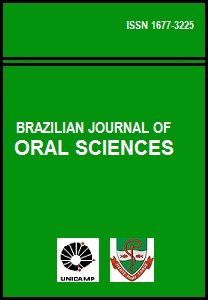Abstract
Due to its properties, fluoride (NaF) is widely used in dentistry, as a tool for dental caries control and prevention; nevertheless, the inadequate use of fluoride may cause odontogenesis disturbance and citotoxicity on soft tissues. So that, this report proposed to evaluate the genotoxic effects of NaF under following concentrations: 0, 7, 28, 56 and 100 ppm, on rats’ oral cells in vitro, through the comet assay. The results showed that NaF, in different concentrations analyzed, it did not promote genotoxic alterations on both keratinocytes, with and without lysis of the cytoplasm. Based on the results, it concluded that NaF, in these concentrations tested, it did not cause genotoxic alterations on rats’ oral cells and the comet assay on oral mucosa may be helpful to evaluate the genotoxic potential of some substances usually in contact with oral mucosa as fluoride.References
Denbesten PK, Thariani, H. Biological mechanisms of fluorosis and level and timing of systemic exposure to fluoride with respect to fluorosis. J Dent Res 1992; 71: 1238-43.
Wright JT, Chen SC, Hall KI, Yamauchi M, Bawden JW. Protein characterization of fluorosed human enamel. J Dent Res 1996; 75: 1936-41.
Smith GE. A surfeit of fluoride? Sci Prog Oxf 1985; 69: 429-42.
Kihlman BA. Experimentally induced chromosome aberrations in plants I. The production of chromosome aberrations by cyanide and other heavy metal complexing agents. J Biophys Biochem Cytol 1957; 3: 363-80.
Kleinsasser NH, Weissacher H, Wallner BC, Kastenbauer ER, Harreus UA. Cytotoxicity and genotoxicity of fluorides in human mucosa and lymphocytes. Laryngohinootologie 2001; 80: 187-90.
Kram D, Schneider EL, Singer L, Martin GR. The effects of high and low fluoride diets on the frequencies of sister chromatide exchanges. Mutation Res 1978; 57: 51-5.
Martin GR, Brown KS, Matheson DW, Lebowitz H, Singer L, Ophaug R. Lack of cytogenetic effects in mice or mutations in salmonella receiving sodium fluoride, Mutation Res 1979; 66: 159-67.
Slamenova D, Gabelova A, Ruppova K. Cytotoxicity and genotoxicity testing of sodium fluoride on Chinese hamster V79 cells and human EUE cells. Mutation Res 1992; 16: 109-15.
Gerdes RA. The influence of atmospheric hydrogen fluoride on the frequency of sex-linked lethal and sterility in drosophila melanogaster. Fluoride 1971; 4: 25-9.
Mohamed AH. Cytogenetic effects of hydrogen fluoride treatment in tomato plants. J Air Pollution Control Assoc, 1968;18: 395-8.
Mohamed AH, Chandler ME. Cytological effects of sodium fluoride on mice, presented during hearings, The National Cancer Program, Part 2 – Fluoridation of public drinking water, Washingtion, DC, 95th, Us Congress, 1977, 21: 42-60.
Li Y, Dunipace A, Stookey GK. Long-term exposure to fluoride in drinking water and sister chromatid exchange frequency in human blood lymphocytes. J Dent Res 1995; 74: 1468-74.
Monsour PA, Kruger BJ, Smid JR. Effects of a single intravenous dose of sodium fluoride on plasma electrolytes and metabolites in rats, rabbits and cockerels. J Dent Res. 1985; 64: 1281-5.
Voegel E. Strong antimutagenic effects of fluoride on mutation induction by trenimon and 1-hyenyl-3, 3-dimethyltriazene in drosophila melanogaster. Mutation Res 1973; 20: 239-52.
Kassie, F, Parzefall, W, Knasmuller S. Single cell gel electrophoresis assay: a new technique for human biomonitoring studies. Mutation Res 2000; 463: 13-23.
Singh NP, McCoy MT, Tice RR, Schaeider EL. A simple technique for quantification of low levels of DNA damage in individual cells. Exp Cell Res 1988; 175: 184-191.
Tice RR, Agurell E, Anderson D, Burlinson B, Hartman A, Kobayashi H et al. Single cell gel/comet assay: guidelines for in vitro and in vivo genetic toxicology testing. Envirom Mol Mutag, 2000, 35: 206-21.
Speit G, Hanelt S, Helbig R, Seidel A, Hartman A. Detection of DNA effects in human cells with the comet assay and their relevance for mutagenesis. Toxicol Letters 1996; 88: 91-8.
Vasquez M, Tice RR. Comparative analysis of apoptosis versus necrosis using the single cell gel (SCG) assay. Environ Mol Mutag 1997; 29: 53.
Kasamatsu T, Kohda K, Kawazoe Y. Comparison of chemically induced DNA breakage in cellular and subcellular systems using the comet assay. Mutation Res 1996; 369: 1-6.
Rojas E, Valverde M, Sordo M, Ostrosky-Wegman P. DNA damage in exfoliated buccal cells of smokers assessed by the single cell gel electrophoresis assay. Mutat Res 1996; 370: 115-20.
Mckelvey-Martin VJ, Green MHL, Schmezer P, Pool-Zobel BL, De Méo MP, Collins A. The single cell gel electrophoresis assay (comet assay): A European review. Mutat Res 1993; 288: 47-63.
Denbesten PK. Effects of fluoride on protein secretion and removal during enamel development in the rat. J Dent Res 1986; 65:1272-7.
Denbesten PK, Crenshaw MA. The effects of chronic high fluoride levels on forming enamel in the rat. Arch Oral Biol 1984; 29: 675-9.
Jeng JH, Hsieh CC, Lan WH, Chang MC, Lin SK, Hahn LJ, et al. Citotoxicity of sodium fluoride on human oral mucosa fibroblasts and its mechanisms. Cell Biol. Toxicol 1998; 14: 383-9.
Jackson R, Kelly S, Noblitt T, Zhang W, Dunipace A, Li Y, et al. The effect of fluoride therapy on blood chemistry parameters in osteoporotic females. Bonne Miner 1994; 27:13-23.
World Health Organization (WHO). Available from: URL: http://www.edoc.za/dentalnet/who/fluoride.html.
Smith CE, Nanci A, Denbesten PK. Effects of chronic fluoride exposure on morphometric parameters defining the stages of amelogenesis and ameloblast modulation in rat incisor. Anat Rec 1993; 237: 243-58.
The Brazilian Journal of Oral Sciences uses the Creative Commons license (CC), thus preserving the integrity of the articles in an open access environment.

